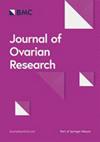Long non-coding ribonucleic acid SNHG18 induced human granulosa cell apoptosis via disruption of glycolysis in ovarian aging
IF 3.8
3区 医学
Q1 REPRODUCTIVE BIOLOGY
引用次数: 0
Abstract
In-depth understanding of dynamic expression profiles of human granulosa cells (GCs) during follicular development will contribute to the diagnostic and targeted interventions for female infertility. However, genome-scale analysis of long non-coding ribonucleic acid (lncRNA) in GCs across diverse developmental stages is challenging. Meanwhile, further research is needed to determine how aberrant lncRNA expression participates in ovarian diseases. Granulosa cell-related lncRNAs data spanning five follicular development stages were retrieved and filtered from the NCBI dataset (GSE107746). Stage-specific lncRNA expression patterns and mRNA-lncRNA co-expression networks were identified with bioinformatic approaches. Subsequently, the expression pattern of SNHG18 was detected in GCs during ovarian aging. And SNHG18 siRNA or overexpression plasmids were transfected to SVOG cells in examining the regulatory roles of SNHG18 in GC proliferation and apoptosis. Moreover, whether PKCɛ/SNHG18 signaling take part in GC glycolysis via ENO1 were verified in SVOG cells. We demonstrated that GC-related lncRNAs were specifically expressed across different developmental stages, and coordinated crucial biological functions like mitotic cell cycle and metabolic processes in the folliculogenesis. Thereafter, we noticed a strong correlation of PRKCE and SNHG18 expression in our analysis. With downregulated SNHG18 of GCs identified in the context of ovarian aging, SNHG18 knockdown could further induce cell apoptosis, retard cell proliferation and exacerbate DNA damage in SVOG cell. Moreover, downregulated PKCɛ/SNHG18 pathway interrupted the SVOG cell glycolysis by lowering the ENO1 expression. Altogether, our results revealed that folliculogenesis-related lncRNA SNHG18 participated in the pathogenesis of ovarian aging, which may provide novel biomarkers for ovarian function and new insights for the infertility treatment.长非编码核糖核酸 SNHG18 在卵巢衰老过程中通过干扰糖酵解诱导人类颗粒细胞凋亡
深入了解人类颗粒细胞(GCs)在卵泡发育过程中的动态表达谱将有助于诊断和有针对性地干预女性不孕症。然而,在不同发育阶段对颗粒细胞中的长非编码核糖核酸(lncRNA)进行基因组规模的分析具有挑战性。同时,要确定异常lncRNA表达是如何参与卵巢疾病的,还需要进一步的研究。我们从NCBI数据集(GSE107746)中检索并筛选了跨越五个卵泡发育阶段的粒细胞相关lncRNAs数据。通过生物信息学方法确定了特定阶段的lncRNA表达模式和mRNA-lncRNA共表达网络。随后,研究人员检测了卵巢衰老过程中SNHG18在GCs中的表达模式。并将SNHG18 siRNA或过表达质粒转染至SVOG细胞,研究SNHG18在GC增殖和凋亡中的调控作用。此外,还在 SVOG 细胞中验证了 PKCɛ/SNHG18 信号是否通过 ENO1 参与 GC 糖酵解。我们证实,与 GC 相关的 lncRNAs 在不同发育阶段均有特异性表达,并协调着卵泡生成过程中的有丝分裂细胞周期和代谢过程等关键生物功能。此后,我们在分析中发现,PRKCE和SNHG18的表达具有很强的相关性。随着卵巢衰老背景下GCs SNHG18的下调,SNHG18的敲除可进一步诱导SVOG细胞凋亡、延缓细胞增殖并加剧DNA损伤。此外,PKCɛ/SNHG18 通路的下调通过降低 ENO1 的表达干扰了 SVOG 细胞的糖酵解。总之,我们的研究结果表明,卵泡生成相关的lncRNA SNHG18参与了卵巢衰老的发病机制,这可能为卵巢功能提供新的生物标志物,并为不孕症的治疗提供新的见解。
本文章由计算机程序翻译,如有差异,请以英文原文为准。
求助全文
约1分钟内获得全文
求助全文
来源期刊

Journal of Ovarian Research
REPRODUCTIVE BIOLOGY-
CiteScore
6.20
自引率
2.50%
发文量
125
审稿时长
>12 weeks
期刊介绍:
Journal of Ovarian Research is an open access, peer reviewed, online journal that aims to provide a forum for high-quality basic and clinical research on ovarian function, abnormalities, and cancer. The journal focuses on research that provides new insights into ovarian functions as well as prevention and treatment of diseases afflicting the organ.
Topical areas include, but are not restricted to:
Ovary development, hormone secretion and regulation
Follicle growth and ovulation
Infertility and Polycystic ovarian syndrome
Regulation of pituitary and other biological functions by ovarian hormones
Ovarian cancer, its prevention, diagnosis and treatment
Drug development and screening
Role of stem cells in ovary development and function.
 求助内容:
求助内容: 应助结果提醒方式:
应助结果提醒方式:


